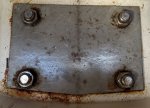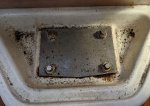HappyHurley
Member
For those with more experience than me please [my last boat was an encapsulated long keel] is this likely superficial, or something more sinister that would require dropping the keel to investigate ?
These are the forward studs. There are four more aft in a similar arrangement [with less visible corrosion].
Background: the boat has been lying afloat unused and neglected for the last couple of seasons [so no heating, or dehumidifier].
These are the forward studs. There are four more aft in a similar arrangement [with less visible corrosion].
Background: the boat has been lying afloat unused and neglected for the last couple of seasons [so no heating, or dehumidifier].





